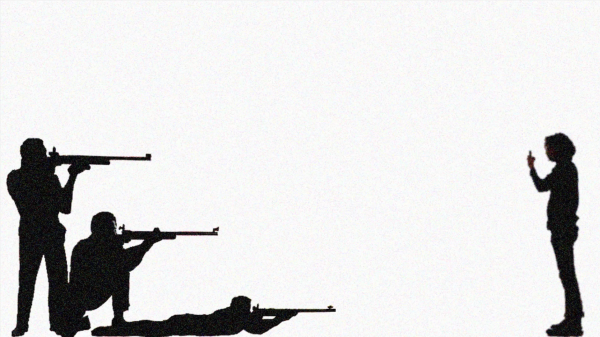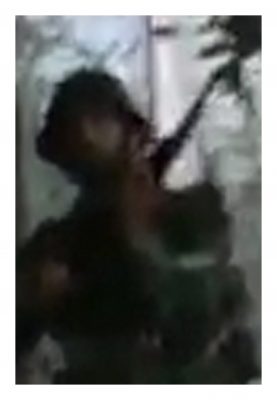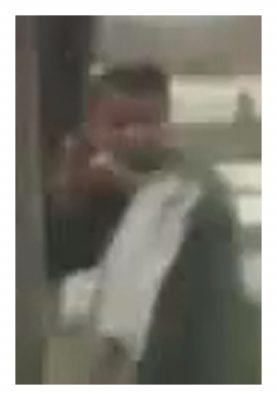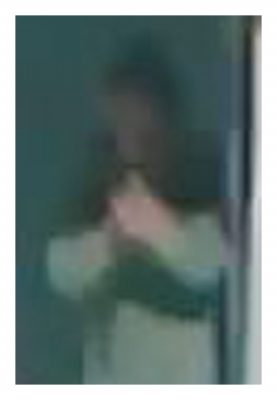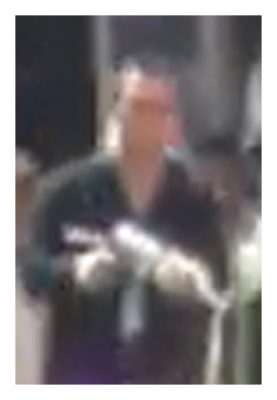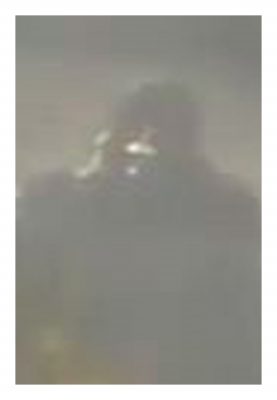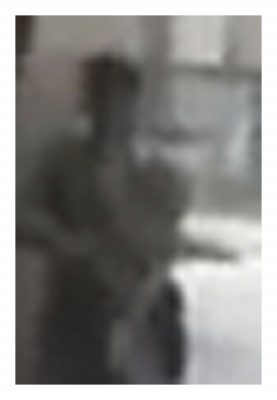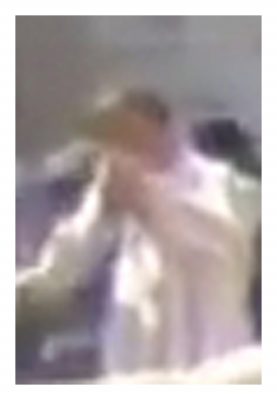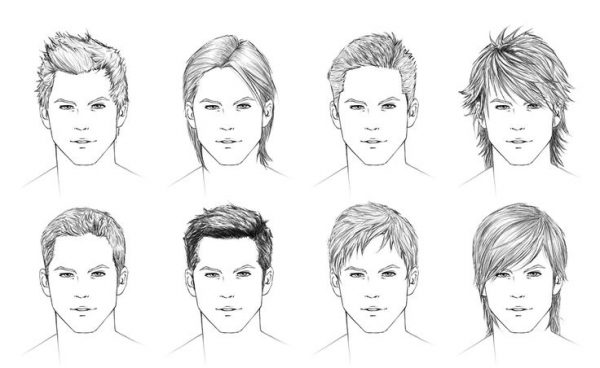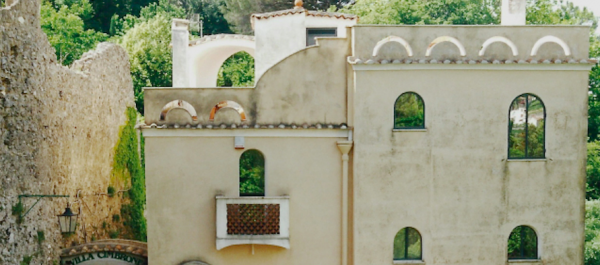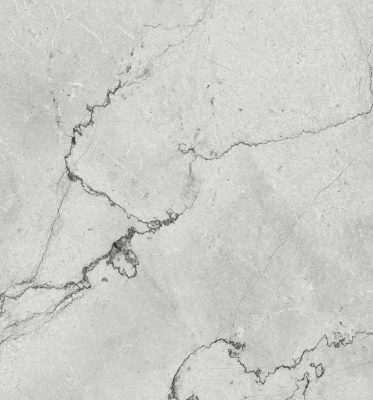In his pencil-like embrasure, the look-out and later the gunner realised long before the easel painter, the photographer or the filmmaker how necessary is a preliminary sizing-up. ‘You can see hell much better through a narrow vent than if you could take it in with both eyes at once,’ wrote Barbey D’Aurevilly, evoking the sort of squint necessary in taking aim and firing.
— Paul Virilio [1]
I
I first saw Rabih Mroué’s work exhibited in the final gallery of the 2015 group exhibition ‘Scenes for a New Heritage: Contemporary Art from the Collection’ at the Museum of Modern Art in New York. His piece The Fall of a Hair: Blow Ups (2012) was exhibited alongside an installation featuring Hito Steyerl’s video November (2004), and just outside the cavernous and minimalist installation Lament of the Images (2002) by Alfredo Jaar. Mroué’s work consists of a row of seven identically sized colour inkjet prints, unframed and printed with even white borders, each over four feet tall. Installed at the end of a long corridor, the works were hung by small silver clips in their upper corners against a sombre black wall, their bright borders radiating outward in the pallor of the lighting.
Seen from the far end of the corridor, each image showed the discernible outline of an armed, presumptively male figure, their heads positioned in the upper third of the image, their torsos carrying down to the lower border of the frame in a fairly classical bust composition. The colour of the images varied within a muted set of pastel hues. Their shadows were flat and open, the tones relatively unsaturated, the sun-bleached highlights in each image nearly garish under the gallery’s spotlights. They were affably textured scenes to take in from a distance – seemingly the issue of some taxonomical portrait study or other.
But with each approaching step, the images shifted and warped: the exposed gloss surface of the inkjet prints picked up and refracted every incidental movement of a passing visitor, like distorted satellite reception interrupting the smoothness of a television image, even as the density of each central figure began to degrade, rather than resolve in greater and greater clarity. To approach the images was to lose hold of their initial figurative coherence, and to begin to grasp their fragmentary, pixelated substance – to reckon with their intrinsic optical decay. And as the images deteriorated in legibility, they continually increased in scale, until, at the surface of the print, they enveloped me entirely, even as their depicted content dematerialised into a welter of digital noise.
To the left of the row of prints, the curators had affixed a brief wall text describing the works. Upon reading it, I learned that these were images of gunmen in Syria made during 2011, and created at or around the point where the gunmen recognised themselves to be the subjects of the attention of a cameraphone wielded by a protester or civilian. These were images extracted from the still-ongoing Syrian Civil War, which broke out four years before the exhibition opened, during the uprisings colloquially referred to as the Arab Spring. They were images emerging from a region of that uprising out of which journalistic footage was in minimal supply, and they were at once funereal in the violent action that they figured, or in the violent degradation of their central figures, and inscrutable on a purely visual basis at the level of the event.
The wall text informed me that in some instances the images depicted the last thing seen by their makers before the gunmen fired. Thus, the trajectory that I had travelled to approach the surface of the prints was the inverse of the reciprocal response that the camera’s attentions had occasioned from the gunmen, as they fired back, lethally, at the gaze that framed them as images. I grappled with the flatness of the photographs: their resistance as images to the narrative development of dimensional depth; their aggressive compression. This compression of depth, this steady degeneration of optical resolution, seemed a function of the limits of the devices that made the images, and of the digital files that served as source material for the prints on show. Cameras with small lenses combined with small image sensors do not produce images that describe distance and depth and detail well, and the files that result from them are not easily enlarged to such a scale without a massive loss of quality. This much seemed clear.
But the prints telescope in on an encounter of sights: that of the cameraperson, and that of the gunman. In each instance, or in each role, vision is compacted in upon a deliberately foreshortened and abstracted segment of the visible world – its partial status hyper-enlarged to stand metonymically for the whole of a thing: either an image or a target, to the extent that we can distinguish one from the other in this context. The prints retained that sense of intensified abstraction and compression consonant with this kind of sight, or sighting. They welled up in shimmering colour out of the black space of a surrounding gallery cast into a wholly subsidiary role. The prints asserted themselves as primary figures, in the way that any target or framed subject is converted into a protagonist by the enclosure that at once advances and constrains them within the dramaturgy of the frame. I suspected that Mroué knew this, too.
To the left of that row of prints, Hito Steyerl’s November relates the story of a dear childhood friend of hers, Andrea Wolf, who disappeared into Kurdistan to fight against the repressive Turkish forces engaged in the subjugation of the Kurds, and was executed there in 1998 by Turkish security forces as a ‘terrorist’. Wolf’s body was never repatriated to Germany, so for Steyerl, all that remains of her friend is footage from Steyerl’s very first film, some found footage from a Kurdish television programme, and a memorial poster of Wolf (renamed Ronahi) dedicated to the martyred rebels of the Kurdish Free Women’s Army, which Steyerl discovered alongside a pornographic pin-up in a cinema. Of the most consequential events of Wolf’s life, no accessible record remains. In point of fact, the director of the Kurdish television programme tells Steyerl in an interview, featured within the film:
The whole war zone of North Kurdistan is a white spot on the map. The war took place in a vacuum. There are no witnesses. And in this situation everything is possible.
Syria, too, is a war zone whose contours and events are not recorded by anyone other than government loyalists for state-controlled television, or by civilian protesters at mortal risk to themselves and those near or dear to them. That those of us in the West see none of those images in our mainstream media does not mean that the events themselves have ‘no witnesses’, but rather that there are no images admissible as proof that might corroborate what the Syrians (and the Kurds) already know to be fact. Mroué’s works frame the question of veridiction in relationship to history as a problem not reducible solely to the photograph’s relationship to truth, but also necessarily of truth’s relationship to state power. They show spectral armed figures whom we understand to be perpetrators of state-sponsored violence, caught in what appear to be acts of lethal aggression, the results of which cannot be tendered for verification, since no totalitarian state court would admit its own civilian dead as evidence of state crimes during a civil war. Mroué’s stentorian and recalcitrant colour prints thus enter into a dynamic interplay, in that setting, with the question of the relationship between the visible, the actual and the admissible, or between sense, matter and the law – a set of processes or forces whose correlation is deformed by state violence.
II
Immediately behind Mroué’s The Fall of a Hair: Blow Ups, the curators installed Alfredo Jaar’s iconic and wholly image-less Lament of the Images. The installation begins with three black text panels with white prose backlit and shown along the wall of a dark entrance corridor, the first of which recounts the permanent damage done to the eyes of the ‘non-white’ prisoners incarcerated on Robben Island in South Africa under apartheid, among them Nelson Mandela. These prisoners were conscripted into labouring in a quarry, breaking bright white limestone rocks under the luminous glare of the sun, a labour that damaged their eyesight permanently. The second panel recounts the story of Bill Gates’s acquisition of the Bettmann and United Press International archive (some 17 million images), and his decision to inter the photographs forever in a limestone mine in Pennsylvania, leaving only their digital proxies to circulate in the world. The third and final panel describes the US military’s acquisition of exclusive rights to all satellite imagery of Afghanistan and its neighbouring countries immediately before the launch of Operation Enduring Freedom in 2001. Jaar writes of this move that the ‘agreement has also produced an effective white-out of the operation, preventing western media from seeing the effects of the bombing and eliminating the possibility of independent verification or refutation of government claims.’
As soon as one finishes reading the final text panel, the corridor ends in a narrow entrance to a vaulted rectangular room with bare concrete floors and black walls, centred in the far left-hand end of which is a massive gridded panel emitting coruscating white light into the room. Its effects upon entry are of an instantaneous invasion of the faculty for sight by a sort of brilliant placelessness that is nevertheless grounded in the shape of the rectangular frame. The grammar and technics of 17 representation seize one’s physical capacity to see, and implant there an absence of depicted content so irreducibly present and so utterly lacking in a scene. The work suggests at once that the logic of the illuminated frame, devoid of any image to project, is tyrannical in its unremitting constancy, and that the loss of one’s capacity to differentiate the visible – which is of a piece with the internment of 17 million photographs under the earth, and with the withdrawal of images of imperial wars – represents a loss of human capacity that we would do well to lament. Standing in that irradiating light, I began to see the missing figure that recurs in each of Mroué’s seven portraits: the cameraperson whose seeing of the gunmen occasions the final bullet that causes the loss of all future rights to sight.
The French theorist Paul Virilio writes in his landmark essay War and Cinema: The Logistics of Perception (1989) that from ‘the original watchtower through the anchored balloon to the reconnaissance aircraft and remote-sensing satellites, one and the same function has been indefinitely repeated, the eye’s function being the function of a weapon.’[2] In any terrain subject to militarised imperatives, the capacity to see represents either asset or threat. Throughout the book, Virilio examines the intensification of the militarisation of optics (and of the visible) in the context of the evolution of modern warfare, arguing that ‘alongside the “war machine”, there has always existed an ocular (and later optical and electro-optical) “watching machine” capable of providing soldiers, and particularly commanders, with a visual perspective on the military action underway.’[3] For Virilio, such technological evolution brings about ‘a future in which observation and destruction would develop at the same pace’, the fatal consequences of which are played out in the encounter between the miniaturised cameraphone and the rifle in the streets of Syria – and in Mroué’s work.[4]
In fact, we might think of Mroué’s work in terms of a schism between outside and inside that structures each print in the series. On one side of the image, outside and opposite the depicted figure, stands an absence we cannot reduce, a loss or lack that is a function of the Syrian war’s massive activity of erasure and withdrawal, brought on through the murder of the innocent – a ‘white-out’. On the other side, in decaying resolution but in vibrant colour, is a digital fragment, an enlargement, a JPEG made over into a TIFF made over into a print, made over into an installation image and sent back through the stimulant circuitry of electronic and fibre-optic networks. Its pixels dance to the rhythm of circulation, which is their primary mode of being, just as its printed surface shimmers under light. The cameraperson moves no more. Despite the rapid technological evolution of the cameraphone, the necessity that monocular lenses take up direct lines of sight with the eye of their users and their intended targets made its modernity secondary to the gun sights of an AK-47. And thus, in this fatal encounter, old-fashioned ballistics trump modern processing power.
The militarised conflict at play here over a politics of withdrawal of the visible is eerily redolent of Virilio’s description of a moment in the development of industrialised warfare where ‘the representation of events outstripped the presentation of facts’, and where ‘the image was starting to gain sway over the object, time and space’.[5] This is the modality of our contemporary politics, but here, the ontological power of the image to make manifest that which the gunmen seek to repress has not resulted in the eradication of data, but in the murder of citizens, and what persists for us to reckon with is the final image that precedes their deaths.
As Virilio writes elsewhere in War and Cinema, the ‘intensity of automatic weaponry and the new capacities of photographic equipment combine to project a final image of the world, a world in the throes of dematerialisation and eventual total disintegration’. This seems a serviceable description of all the images in The Fall of a Hair: Blow Ups, and yet one worth parsing further. Virilio is writing here of the necessity to eradicate legible optical images from radar displays, so that radar operators might cease to sense themselves poised above actual people as they look and work. Rather, the reality of the representation and the mechanical set of responses to its changing stimuli needed privileging over and against the reality of the referent. So too in the Syrian street: the production of any imaging of the state other than that of the state interrupts the smooth continuous emission of a distorted image of Syria beneath whose veil the state can continue to act undisturbed. The reality of Bashar al-Assad’s public image of Syria matters more than the condition of its citizenry, and thus we might read the state-sponsored killings of camerapeople as an act of postproduction.
It was only after seeing the MoMA exhibition that I discovered the source material for the photographic images Mroué had shown. These originated in a separate work entitled The Pixelated Revolution (2012), which is both a live scripted lecture performance (something Mroué calls a ‘non-academic lecture’), and a video work commissioned by dOCUMENTA (13). The ‘portraits’ which together constitute The Fall of a Hair: Blow Ups are themselves magnified fragments of larger video stills, re-cast within the rubric and proportions of the ID photograph. Between the two works, and within the same digital material, a forensic process of targeting has transpired that is itself comparable to the investigatory work of the protagonist photographer in Michelangelo Antonioni’s 1966 film Blow-Up. The very form of these excised photographic fragments elides the grammars of portraiture with the aesthetics and processes of surveillance, as Mroué answers the targeting gaze of the gunmen with the compositional strictures of the headshot. In his lecture performances of the piece, and in his 2012 video work, he avers to his audience, in watching this extraordinary footage, that
I would like to find in these videos made by the Syrian protesters the insistence that they are able to distinguish the identities of the murderers, that the filming eye rejects the murderer’s future right to amnesty under any circumstance.
In furtherance of this desire to reverse the withdrawals of optical decay, digital degradation and state secrecy, Mroué conducts a counter-montage of the footage in efforts to fix the identity of the perpetrators, even as the identity of the victims remains unknown. In this effort, he mirrors the nineteenth-century practice of optography, in which scientists and physiologists sought to print the final images imprinted on the retina of the dead – retina which in these instances would have been fixated on the screen image of the murderers targeting them with rifles. He confesses in his performance: ‘I printed the video frame by frame, in separate still images, and looked at them carefully. This was my attempt, as with optography, to sketch a picture of the murderer and reveal his personal identity – a desire to know his first name and his family name, for he and all the other murderers could otherwise walk among us tomorrow anonymous, as if nothing had happened.’
The Pixelated Revolution is thus concerned at once with the impossibility and the necessity of history within the confines of what theorist Ariella Aïsha Azoulay has called ‘regime-made disaster’, in which the government – in the notional prosecution of justice – claims to fight an invading force whilst murdering its own citizens by the tens of thousands, all safely within the confines of the law, so that the planned erasure of a people and the production of new facts collude in the secrecy of withdrawal and disavowal.[6] The videos from which Mroué’s piece is fashioned are dying declarations, declarations in which the very inscription of a historical event demands an act of self-immolation, so that the birth of the image and the death of its creator – the birth of the reader and the death of the author – are bonded in indivisible, dialectical relation. Linguist and sociologist Jon Rich writes:
The image-makers of Syria, for the first time in history, simultaneously occupied two enormous roles: the role of the victim and that of hero. The Syrian photographer is a protester, but instead of filming the crowd he films his own personal death. It is a form of suicide against the cameras that spares no one, even if the world’s networks refrain from broadcasting its images. The protester in Syria is simultaneously a victim of bare repression and a historian.[7]
Any cursory search of Google Video or YouTube can quickly unearth a stream of such videos in continuous circulation, and more orbit via Facebook and elsewhere online. Thus the withdrawal at play here is complex: a steady stream of ‘unverifiable’ footage emerges from Syria following the deaths of those that produce such footage as record, and as final will and testament. In the chaos that ensues during such an unrestrained and totalising civil war, the camerapersons disappear (perhaps to safety, perhaps in death) but their images arise in their wake. So then a certain abundance characterises both sides of Mroué’s images: an abundance of gunmen in Syria, and an abundance of the dead, both numbering in the hundreds of thousands. Indeed, as far back as 2015, a trove of over 55,000 photographs – a significant proportion of which document the death of over 6,700 detained Syrian civilians – was handed over to Human Rights Watch, giving some fractional indication of the broader scale of systematic slaughter at play.[8] There are both witnesses and images in abundance. To subject them to standard veridical procedures in the wake of a catastrophe of such incomprehensible scale is to rule the experience of that catastrophe wholly inadmissible to ‘legitimate’ discourse, since it is irreducible to the norms by which our institutions establish facts. A brief vignette appearing in the Economist in September 2019 should suffice to bear this out:
Eight years into a savage war, the images still numb. Near the village of Haas, a headless child lies amid the rubble of bombed homes. In the town of Ariha, an infant dangles several storeys up from the wreckage of another building while her father looks on in horror. There is smoke and dust and blood, gnarled metal and smashed concrete, and the vacant stares of people who have endured almost a decade of violence.[9]
Such forms of war eviscerate both peoples and the conditions essential to justice, in order to write their founding violences out of the new histories on which the state will be built. The dead must be expurgated. Beyond the identity of the gunmen that recedes beneath the pixelated surface of Mroué’s prints, beyond the civilian/state struggle over the rights to image the visible, and beyond even the withdrawal of the camerapersons and protesters from the lethal scenes they depict, what has withdrawn in such wanton devastation is the intricate entanglement of a web of communities now scattered to the corners of the earth. They number some 5.6 million refugees in 2020, which equates to 26 per cent of the total 2010 population of Syria.[10] They carry with them and leave in their wake what the artist and theorist Jalal Toufic has called ‘a surpassing disaster’, which ‘cannot be ascertained by the number of casualties, the intensity of psychic traumas and the extent of material damage, but by whether we encounter in its aftermath symptoms of withdrawal of tradition’ – symptoms of the death of a lifeworld.[11]
III
Given the unassimilable nature of this war, how should we respond to our capacity (our freedom) to take up the role of spectators of its images? How should we respond to our capacity to hold what occurs in such sites at a distance? Does a refusal to look at such depictions equate to a disavowal of the events themselves, or a rejection of our forceful interpellation into the place of the image by the power of the frame? Does it equate to a refusal to be subject to the forces that come into play when one, following French philosopher Maurice Blanchot, lives an event as an image? Blanchot writes:
To live an event as an image is not to remain uninvolved, to regard the event disinterestedly in the way that the aesthetic version of the image and the serene ideal of classical art propose. But neither is it to take part freely and decisively. It is to be taken: to pass from the region of the real where we hold ourselves at a distance from things the better to order and use them into that other region where the distance holds us – the distance which then is the lifeless deep, an unmanageable, inappreciable remoteness which has become something like the sovereign power behind all things.[12]
Might it be that what we most resist, in the image of a headless child strewn amidst rubble, or in the live sights of the gunman, is not only the horror of such violence, but the world’s (and the image’s) pitiless indifference to such finality? Do we perhaps mirror that indifference in our aversion from the scene: the image ultimately turning from us in death as we now turn from its horrors in life? If the French critic and theorist Roland Barthes is correct in declaring that a ‘sort of umbilical cord links the body of the photographed thing to my gaze’, and that ‘light, though impalpable, is here a carnal medium, a skin I share with anyone who has been photographed’, then what world do we weave together through our refusal of such images?[13]
Mroué has written scathingly of the continuous broadcasts in Lebanon, during the Israeli invasion of Southern Lebanon in 2006, of ‘abundant and continuous images aired on television stations of dismembered and scorched corpses, and of corpses buried under rubble’, flatly declaring that the ‘dead were filmed in the absolute. Everything was placed in front of the lens to be filmed and exhibited all at once.’[14] He has argued that the capacity to broadcast those images was preserved during the Israeli assault so that the Lebanese ‘may watch our own death, live on television screens’, claiming that ‘every image is there, only to delete the image preceding it. And I have seen nothing until now. Sometimes I think I am nothing but an image that others have seen and deleted.’
Mroué’s prose echoes the opening lines of Alain Resnais’s classic 1959 film Hiroshima mon amour, which deals with the utter incommunicability of catastrophe. Just as Antonioni’s Blow-Up surfaces in the subtitle to The Fall of a Hair, so too here: cinema serves as a marker for the osmotic relays by way of which fictive images work through the grammars of the mind, and through feeling and action reshape the terrain of the real. Mroué understands the ways in which images and affects transubstantiation, and his work takes up the vitality of these elusive forms across a range of mediums, from collage to drawing, from photography to video to installation to the lecture performance. In this last form, Mroué plays the images with which he is concerned not merely in the chronological sense of repeating a sequence, but in the sense of putting an image’s rhetorical conditions into play, so that we might watch it work, and reckon with how it (and we and its world) behaves.
Mroué’s commitment, in these performances, to narrating and re-narrating the experience of encountering the images he looks at is central to this effort, as is his insistence on the animacy, the life of the images themselves as actors out in the world on their various stages. This approach enables him to surface and examine the dramaturgy of the image and the alterable, contingent circuits of perception. Thus, in his 2008 lecture performance The Inhabitants of Images, Mroué studies the propagandistic deployment of serial iconic portraits of martyred Hezbollah soldiers, attached high up to streetlights facing in both directions and running down the centre of a wide boulevard in Lebanon. He asks:
…when were these pictures taken? Did they know that they were going to die, so these pictures were kept aside, ready to be used after their death for such posters, as a tribute to their sacrifice?[15]
In his simple probing, Mroué conjures the improbable mirage of a portrait studio set up during Hezbollah’s rolling recruitment intake, in order to demonstrate how the stability of image rhetorics like studio portraits might veil deeper contradictions. He continues: ‘Why were military clothes chosen as a uniform, and not religious clothing…? […] I wonder about this because the military clothes do not have an identity; it can belong to any army in the world, including the enemy army itself. Why did they decide to appear in this Westernised military outfit, a common, globalised one?’ For a Shia Islamic organisation aligned with Iran, and so vehemently opposed to the West, the decision troubles his curious eye, and so he goes on looking, peeling back layers of signification:
The strange thing about the photos is the body of each martyr. I discovered that it’s the same body in each photo. These photos are nothing but a montage of pictures. And the tricks of the montage are hidden in order to produce this illusion… If you look carefully you can see that the body of the fighter in the poster does not belong to the face. It is an unknown body.
Not only does the intake portrait studio not exist, but the body symbolising martial bravery bears no material relation to the series of heads that adorn it, and it’s likely that the usefulness of that generic military torso within the realms of image-editing dictated the use of uniforms over and above religious dress. Beneath strident performances of cultural specificity, Mroué unearths the generic Taylorist codes of mass image production. He writes: ‘It seems that the graphic designers of Hezbollah prepared a special poster to greet their martyrs. One poster for all. One poster for each martyr.’ The grammars of the Hezbollah Party’s sectarian iconography are laid bare in their stark resemblance to consumerist mass production, suggesting an affinity between ideologies we are otherwise instructed to see as being in permanent, violent, diametric opposition. The efficacy of hegemonic image strategies aimed at shoring up party political support instead begin to reveal commonalities that the men of Hezbollah might wish to disavow.
Mroué insists on the possibility that these images are alive, asking what happened to the personal bodies of the depicted heads:
…is it because the image, which has become one of the Party’s main strategic weapons in its war, rejects a body that does not comply with the conditions of this war, a war that is waged in the field of the media? Does the society of resistance fear the bodies of its members, to the extent that it amputates them and throws them aside?
Suddenly icons of authority have become figures of pathos, and yet as individuals dispossessed even of their ideological moorings, as scattered digital body parts in the white space of digital (re)composition, and out on the street as though poorly dressed actors on a stage. Mroué’s subtle interrogative engagement with ‘the inhabitants of images’ as agents in a performance for an audience unveils the arbitrary and contingent construction of Hezbollah’s symbolic absolutes. In particular, it reveals the simultaneous reification and repression of the male body as integral to Hezbollah’s effort to monumentalise masculinity writ large: under the conditions of this image war, only the right type of male body can memorialise the dead. In this analysis, Mroué unsettles unstated precepts intrinsic to the heteronormativity of these iconic images. He puts the images into motion in the rhetorical space of the public street, by attending to the manner in which they are intended to be experienced, remarking that:
They are spread in the middle of this wide boulevard, whose mission is to facilitate the flow of traffic; slowing down is not allowed, and there is no walking space for passers-by. The only probable way for us to see one frame, in a clear manner, is either to run very fast, or to drive, while looking at the posters. Each picture would then be one frame in one extended cinema reel, a cinematic sequence, and our movement would put the frames in motion, like watching a film. And since the frames are all similar, except for the head and the name, we end up seeing only one, still image; the image of the martyr Mujahid, in the body of a warrior, without a name or a face.
Here, Mroué has reversed and then set in motion the dramaturgy of the scene, noting that the successive and serial exposure to the portraits will elide their individuality, an elision that evacuates from the memorial gesture of the portraits the specificity of identity to which they pretend. Their installation reifies the genus in their taxonomy and not the individuated aspect of each martyr. In this way, a memorial spectacle that on its surface aims toward the celebration of a unique individual can be read in its actions as a rearguard effort to preserve the very notion of martial sacrifice as a central genre of masculinity fraught with complex bodily disavowal.
In writing this essay, I returned to Mroué’s practice at the tail end of the summer of the Beirut port blast, which killed more than 200 people, injured 6,500, and left over 300,000 Lebanese homeless. Those months marked at once the inaugural summer of the Covid-19 pandemic, a fresh Ebola outbreak in the Democratic Republic of the Congo, and the eruption of massed international support for the Movement for Black Lives in the wake of the police murders of Breonna Taylor and George Floyd. In that interval, and subsequent to the faded intensity of those events, the sociality of the image and the ubiquity of trauma and devastation were and are inescapably at the centre of our social worlds. There is no realm outside the image, or the text – no space wholly external to the mediation of events and to the continual circulation of those mediations as forms of fraught but fervent connection. Under the conditions of a pandemic, we might even venture to say that such connections as words and images offer us may form an impoverished proxy for touch, even if they continue to represent weapons to be wielded against our senses.
The task, then, must be to cultivate a kind of practice, a mode of that can restore a sense of our dynamic, interconnected and embodied specificities. To do this, we must watch how images show, attend to how they act, and in doing so enumerate and articulate their frail certitudes and powerful ambiguities with and for one another. Such a commitment, shared, would define seeing as a necessarily social practice. This would mean developing a way of being with images in the plurality of their possibilities, and in open embrace of their capacity to sunder the linear division of sequential time by making pasts happen again and again in new and evolving presents. This would mean embracing a mode of relation to the image in which, whatever its potency, we are not perpetually and solely subject to the image’s incidental force, but are alert to the means by which such force is produced, and to the relations of power that its efficacy so often veils.
Mroué’s is a practice that takes seriously, and playfully, the extent to which our senses and our cognition are under perpetual assault within the context of a world in which, as he has written, ‘attitudes and policies’ increasingly ‘transform killing, mass genocide, or martyrdom in the name of The Nation into a normal and ordinary scene.’[16] We can ill afford to lose touch with the complex relays between sense and thought under such conditions, whatever role art might play in a broader spectrum of urgent strategies of resistance. It is through the interaction of word and image in such lecture performances as these – in the sounding-out of the image’s contingency, its facture, and the inner logics of its symbolic tasks – that Mroué is able to make visible ‘the forcible dramaturgy’ essential to ‘the operation of the frame’.[17] I borrow here from the work of philosopher and theorist Judith Butler, in her essay ‘Torture and the Ethics of Photography’ (2007), since her concern there is with the possibility of a photographic practice that might make visible the coercive political mandates and interpretive strictures that regulate and frame the field of the visible. It seems to me that this is also Mroué’s task, or gift: to show the unmarked constraints that work to police our interactions with images, and to map for us their structural flaws; to unmoor and upend the most rigidly normative of image practices; to keep open and mobile even the most viscerally intolerable of sights; to resist, always, the (fore)closure of the visible. This is vital, now if ever: autocracy cannot abide the multiplicities of meaning.
[1] Paul Virilio, tr. Patrick Camiller, War and Cinema: The Logistics of Perception (Verso Books, 1989), p.63
[2] Ibid, p.4
[3] Idem
[4] Ibid, p.85
[5] Ibid, p.1
[6] Azoulay defines a regime-made disaster as follows: ‘Its visible measures are expulsion, dispossession, and destruction related to “others”. These are inflicted by one population of governed – usually the citizens, the privileged ones – upon another; it makes itself invisible to this population of citizens who are mobilised to partake in it, especially because it is not perceived as a disaster; they do not perceive themselves as those who inflict such a disaster or are responsible for its outcome.’ Ariella Aïsha Azoulay, ‘Potential History: Thinking Through Violence’, Critical Inquiry, vol. 39 no. 3 (Spring 2013), pp.549-50
[7] Jon Rich, ‘The Blood of the Victim: Revolution in Syria and the Birth of the Image-Event’, in e-flux Journal, #26 (June 2011)
[8] Human Rights Watch, ‘If the Dead Could Speak: Mass Deaths and Torture in Syria’s Detention Facilities’, 16 December 2015
[9] ‘Briefing: Wings over prayers – Syria’s war is drawing to a close. But the pain will go on’, the Economist, 5 September 2019
[10] United Nations High Commission on Refugees, Syria Regional Refugee Response.
[11] Jalal Toufic, ‘Credits Included’, in The Withdrawal of Tradition Past a Surpassing Disaster (Forthcoming Books, 2009), p.13
[12] Maurice Blanchot, tr. Ann Smock, ‘The Two Versions of the Imaginary’ in The Space of Literature (University of Nebraska Press, 1982), p.261
[13] Roland Barthes, tr. Richard Howard, Camera Lucida: Reflection on Photography (Hill & Wang, 1981), p.81
[14] Rabih Mroué, ‘War 2006’, in Image(s) mon amour (CA2M, 2013), p.401
[15] Rabih Mroué, ‘The Inhabitants of Images’, in Image(s) mon amour, p.348
[16] Mroué, ‘War 2006’, p.400
[17] Judith Butler, ‘Torture and The Ethics of Photography’, Environment and Planning D: Society and Space, vol. 25 (2007), p.953
share
ABOUT THE CONTRIBUTOR
Stanley Wolukau-Wanambwa is a photographer, writer and professor based in the United States of America.
